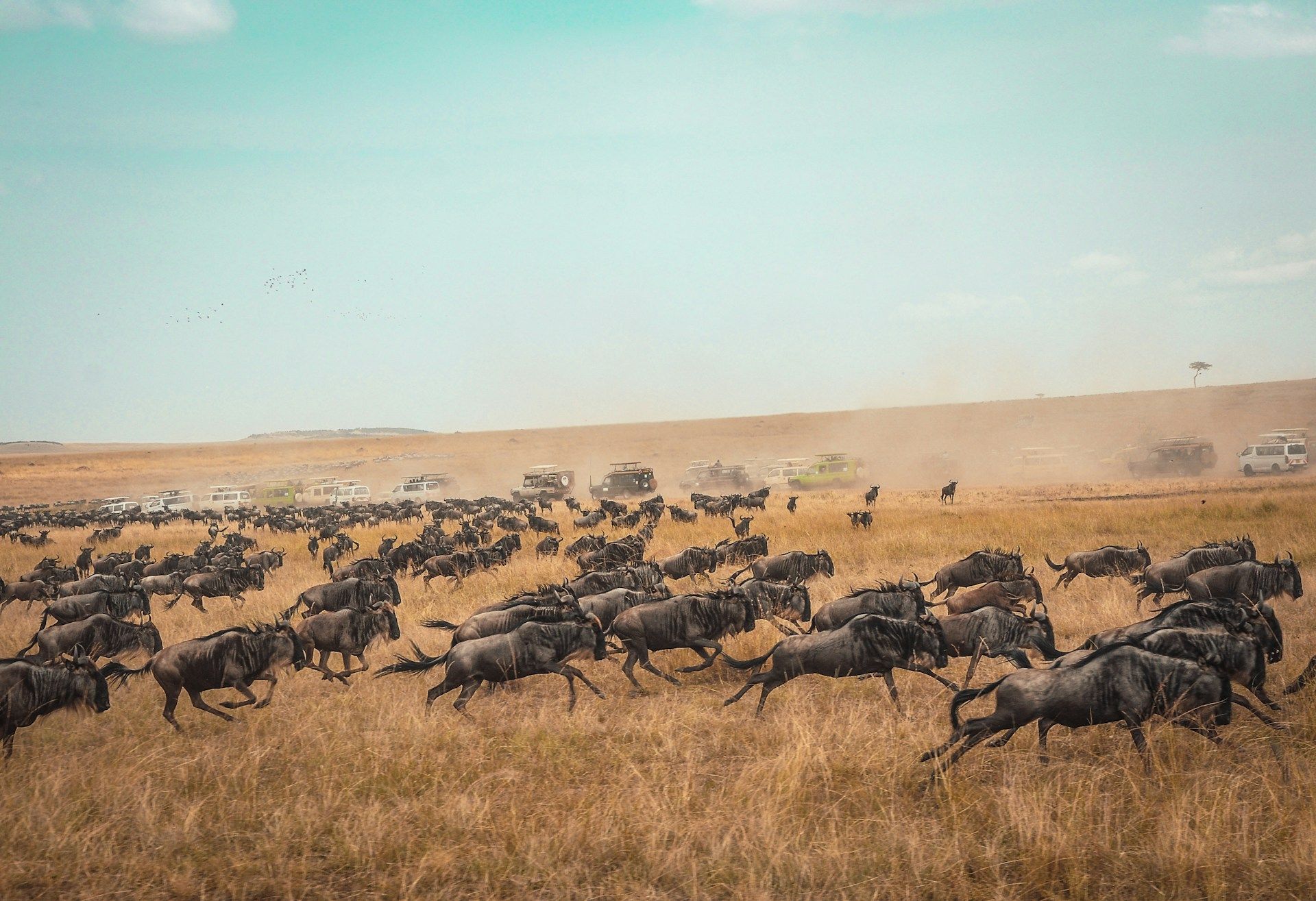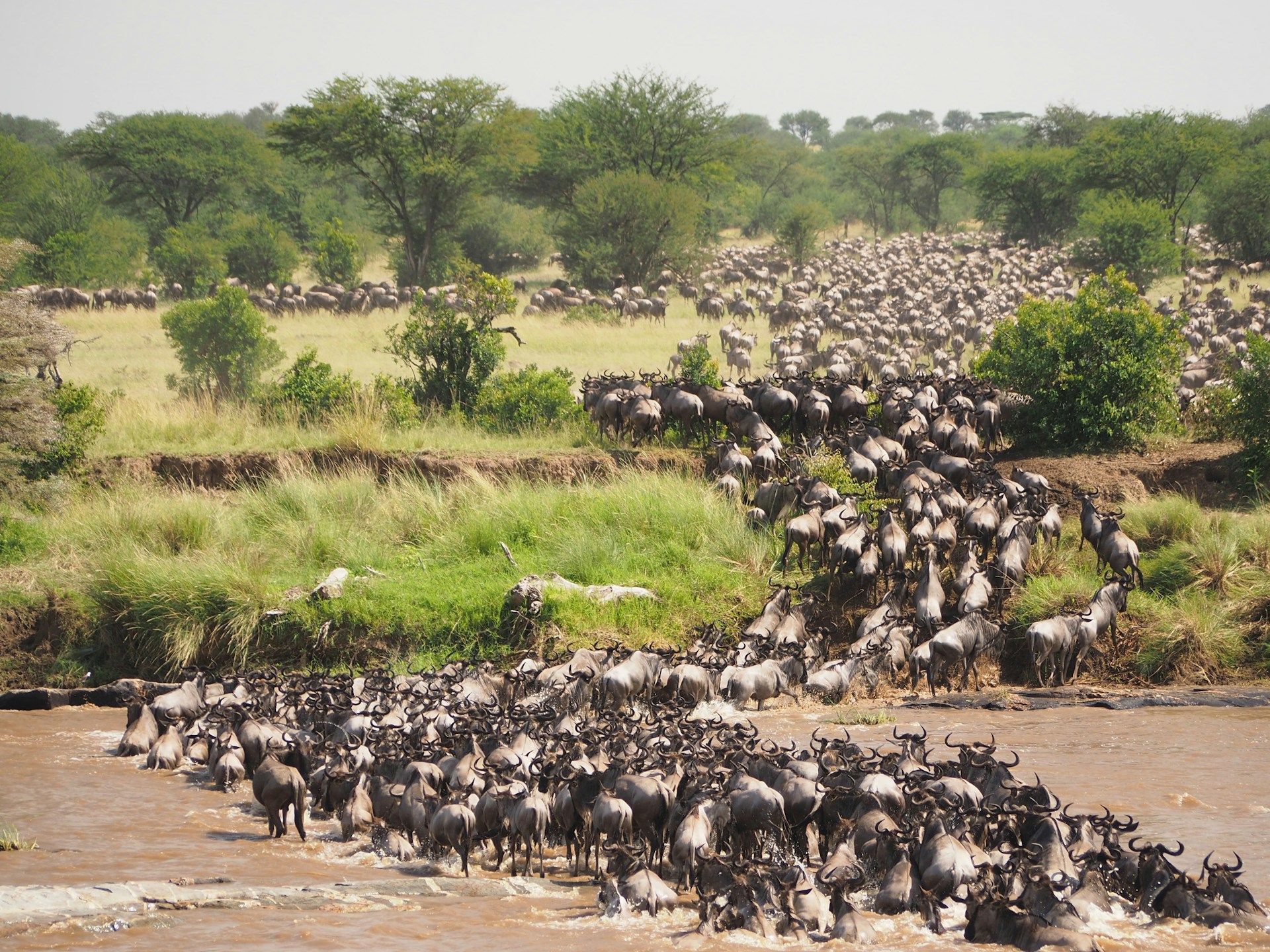
The Great Migration in Kenya: When & Where to Witness It
5 min readThe Great Migration stands as one of nature's most spectacular phenomena, drawing wildlife enthusiasts from around the globe to witness millions of wildebeest, zebras, and gazelles traverse the East African savanna. While this incredible journey spans across Kenya and Tanzania, Kenya offers some of the most dramatic and accessible viewing opportunities for this natural wonder.
What Is the Great Migration?
The Great Migration is an annual circular movement of approximately 1.5 million wildebeest, accompanied by hundreds of thousands of zebras, Thomson's gazelles, and other antelope species. This massive herd follows ancient instinctual patterns, moving in search of fresh grazing pastures and water sources across the Serengeti-Mara ecosystem.
The migration is driven by rainfall patterns and seasonal changes, making it a dynamic event that varies slightly each year. The animals follow a roughly clockwise route, spending different parts of the year in various regions of the Serengeti National Park in Tanzania and the Maasai Mara National Reserve in Kenya.
When to Witness the Migration in Kenya
Peak Season: July to October
The best time to witness the Great Migration in Kenya is during the dry season from July to October, when the massive herds cross from Tanzania's Serengeti into Kenya's Maasai Mara. This period offers the most reliable wildlife viewing opportunities.
July to August: The herds begin arriving in the Maasai Mara, creating incredible concentrations of animals across the reserve. River crossings at the Mara and Talek rivers become frequent and dramatic.
September to October: Peak migration period in Kenya. The herds are well-established in the Mara, and predator activity intensifies as lions, leopards, cheetahs, and crocodiles take advantage of the abundant prey.
Shoulder Seasons
June: Early arrivals begin filtering into the Mara. Wildlife viewing is excellent with fewer crowds and often better accommodation rates.
November: The herds start moving south toward the Serengeti. This can be an excellent time for photography with dramatic skies and fewer tourists.

Where to Witness the Migration in Kenya
Maasai Mara National Reserve
The Maasai Mara serves as Kenya's primary stage for the Great Migration. This 1,510-square-kilometer reserve in southwestern Kenya borders Tanzania's Serengeti National Park, forming one continuous ecosystem.
Key Areas Within the Mara:
Mara Triangle: Located west of the Mara River, this conservancy offers excellent game viewing with well-maintained roads and fewer vehicles. The area is known for spectacular river crossings and high predator concentrations.
Eastern Mara: The main reserve area featuring rolling grasslands and scattered acacia trees. This region typically sees the highest concentrations of migrating animals.
Mara River: The lifeline of the ecosystem and site of the famous river crossings. The river creates a natural barrier that the herds must navigate, often resulting in dramatic scenes as animals brave crocodile-infested waters.
Private Conservancies
Several private conservancies border the Maasai Mara, offering exclusive wildlife experiences with fewer crowds:
Ol Kinyei Conservancy: Directly south of the Mara, this conservancy provides intimate wildlife encounters and excellent photographic opportunities.
Naboisho Conservancy: East of the main reserve, known for its healthy lion populations and diverse wildlife.
Ol Choro Oirowa Conservancy: Offers walking safaris and night drives, providing a different perspective on the migration.
The Famous River Crossings
The Mara River crossings represent the most iconic and dramatic moments of the Great Migration. These crossings occur at various points along the river, with some locations offering better viewing opportunities:
Main Crossing Points:
- Paradise Crossing
- Lookout Hill Crossing
- Double Crossing
The crossings are unpredictable and can happen multiple times per day or not at all for several days. Patience is essential, but witnessing thousands of animals plunging into crocodile-infested waters creates unforgettable memories.
Planning Your Migration Safari
Accommodation Options
Luxury Lodges: Properties like Angama Mara, Four Seasons Safari Lodge, and Mahali Mzuri offer premium experiences with excellent positioning for migration viewing.
Mid-Range Options: Mara Serena Safari Lodge, Keekorok Lodge, and various tented camps provide comfortable accommodations at more moderate prices.
Budget Camping: Public campsites and budget camps offer affordable access to the migration for budget-conscious travelers.
Safari Tips
Book Early: Migration season represents peak safari season in Kenya. Accommodations fill up months in advance, especially for July through September.
Choose Your Location Wisely: Stay within or close to the migration path. Properties along the Mara River or in the Mara Triangle often provide the best access.
Be Flexible: Migration patterns can vary based on rainfall and other factors. Maintaining flexibility in your itinerary increases your chances of witnessing spectacular wildlife moments.
Pack Appropriately: Bring warm clothing for chilly mornings, sun protection for midday heat, and good binoculars for wildlife viewing.
Beyond the Migration
While the Great Migration draws most visitors, the Maasai Mara ecosystem offers incredible wildlife experiences year-round:
Resident Wildlife: The Mara hosts substantial populations of lions, elephants, buffalo, leopards, and cheetahs throughout the year.
Bird Watching: Over 450 bird species call the Mara home, making it a paradise for bird enthusiasts.
Cultural Experiences: Visits to Maasai villages provide insights into traditional pastoralist lifestyles and cultural practices.
Conservation Considerations
The Great Migration faces increasing pressures from climate change, habitat fragmentation, and human encroachment. Supporting responsible tourism operators and conservation-focused accommodations helps ensure this natural wonder continues for future generations.
Many lodges and tour operators contribute directly to conservation efforts and community development programs. Choosing these operators creates positive impacts beyond your safari experience.
Best Photography Tips
Equipment: Bring telephoto lenses (300-600mm) for wildlife photography and wide-angle lenses for landscape shots.
Timing: Early morning and late afternoon provide the best lighting conditions and most active wildlife behavior.
River Crossings: Position yourself upstream from crossing points for better angles and lighting.
Patience: Wildlife photography requires patience. The best shots often come to those who wait for the perfect moment.
Conclusion
The Great Migration in Kenya offers one of the world's most extraordinary wildlife experiences. From the vast herds thundering across the Maasai Mara's golden grasslands to the heart-stopping drama of river crossings, this natural phenomenon creates memories that last a lifetime.
Planning your visit during the peak migration months of July through October maximizes your chances of witnessing this incredible spectacle. Whether you choose luxury lodges or budget camps, the Maasai Mara provides unparalleled access to one of nature's greatest shows.
The Great Migration reminds us of the wild world's raw beauty and the importance of preserving these natural wonders for future generations. Your visit not only fulfills a wildlife dream but also supports conservation efforts that protect this magnificent ecosystem.
Start planning your Great Migration safari today, and prepare to witness one of the most awe-inspiring events in the natural world.